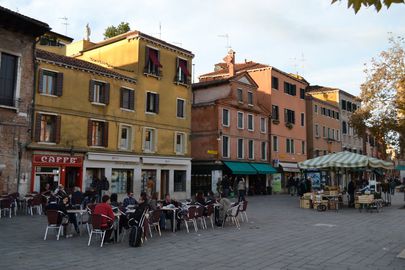

Although religious life was suppressed on this campo two hundred years ago, due to Napoleon's deconsecration of the Church of Santa Margherita on the north side of the square, secular life has thrived ever since. In fact, today the campo is the heart of the student "movida," which is the Spanish word for amusement and nightlife. With the IUAV and Ca' Foscari universities just steps away, the spacious, picturesque campo is a perfect place to get together and down a few beers. The polygon campo is surrounded by bars and restaurants, and at night music thunders from all its corners.
Before the 19th century the campo had a completely different look. There were canals crossing at its south side and many of the buildings were not yet constructed. It was during the Austrian occupation that the campo underwent major reorganization and reconstruction, with the canals being filled in, creating the vastness that we see today.
The little rectangular building at the southern end of the square once used to house the Scuola dei Varoteri, that is, the Confraternity of Tanners. It was erected in the beginning of the 18th century and the brothers moved there from their base in the sestiere of Cannaregio. After the suppression of the confraternity, the building was used to store carbon. In the beginning of the 20th century it housed a movie theater. During the Fascist Era it was turned into a school for Fascist Mysticism, a movement that believed Fascism should be based on mythology and spiritual mysticism. On the building's northern façade we see a bass-relief of the Madonna with Child among the tanners, dating from 16th century. Today, only the limited few have access to the structure, and the city's authorities are still debating what it should be used for.